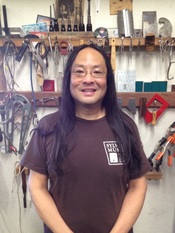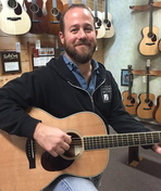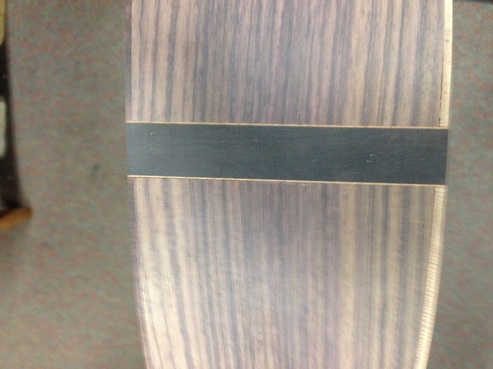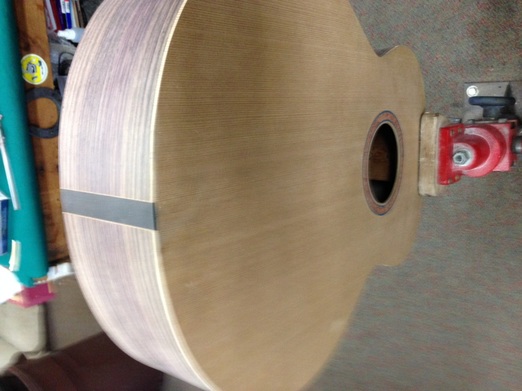|
Question: What piece of gear is equally essential to both beginners and pros alike - regardless of what kind of music they are learning and playing? And what could it be that has great computing power yet costs only $20 or so? Answer: It’s the electronic tuner! This key piece of equipment does so much yet costs so little. It makes it possible for players to quickly and accurately tune their instruments. This makes practicing and playing much more enjoyable. The electronic tuner even makes it possible for large groups of musicians to sound in tune. What would a gathering of ukuleles sound like without the inexpensive clip-on tuner? The evolution of the tuner has come a long way. In the 1930’s Conn introduced the first electronic tuner. It worked on an optical/strobe synchronization principle and was very large, heavy and cost hundreds of dollars. Not portable by any stretch of the imagination. Most of today’s clip-on and pedal tuners work on a frequency-counter principle. A microprocessor counts and clocks the incoming signal, analyzes it and translates the data and displays the results as a note. Pretty amazing for as little as twenty dollars! There are also more expensive clip-on tuners that combine microprocessor and strobe tuning technologies. These offer more extensive features such as alternate temperament tunings and drop key settings. Regardless of what music you play or what you play it on, playing in tune makes music more enjoyable for players and listeners alike.  David Robin got his start in the 1960's Chicago rock n' roll scene and has built up an impressive, lengthy musical resume in the years since. After all these years, his love of the guitar is as strong as ever.
2 Comments
Today I would like to talk about EQ and specifically how it relates to acoustic guitar amplification. I should note that these are solely opinions that I have gathered through my own personal experience and the various research I have done on this topic. Let's take a given range of frequencies produced by, say, an acoustic guitar--the way that our ears naturally interpret those frequencies offers us some clues as to how we might make EQ adjustments on our amp or preamp box. The frequencies that our ears are most attuned to exist in the midrange. Thus, when we plug our acoustic guitar into an amp or PA system (with the system's EQ set to flat), typically a cut (or decrease) somewhere in the range of 200hz-1500khz will yield a more natural and balanced response. Of course there are other factors to consider when tampering with your EQ--at what volume are you playing? Are you a singer songwriter, or are you playing in a group/ensemble? (More on this in my next post!)--however, I have found through personal experience that most acoustic guitars have what I might call a "naughty zone" in the middle frequency range (more often than not in the high-mids) that can be managed adequately with a bit of tone shaping. Try sitting down with your Fishman Loudbox amp or LR Baggs DI sometime and listening carefully to what those little EQ dials do. They were put there for a reason, so why not use them? -McCoy  McCoy Tyler is a salesman at Sylvan Music with an aptitude towards acoustic guitars, amps, and pickup systems. When he's not spouting musical knowledge on the sales floor, he can be found doing some hot picking and sweet singing with his group The McCoy Tyler Band. Strings are very important, don't let anybody tell you otherwise. From ukulele to double bass, the kind of string you use is a huge factor in the sound that will come from your instrument. Finding the right gauge (thickness) is the first step in finding your perfect string match. Make sure your instrument is setup properly otherwise you may be dooming yourself from the get go. I always recommend starting with light gauge since that's right in the middle of the gauge spectrum. If you feel like you want a thicker, heavier feel then you can move up to mediums, heavy's, or some kind of hybrid set. If you want a looser, slinkier feel then you can go to a thinner set like custom or extra lights. As with the instruments, there are more string companies now than ever before so, once you've found your gauge, try a different brand of that gauge every time you restring your instrument. Some companies use different mixes of metals in their strings and some have different core tensions so take note of what you like and dislike about each brand and use that as a reference for your next choice.
Until you settle on the perfect brand and gauge, always keep the empty pack of whatever strings your currently using in your case/gigbag so you don't forget what your using. I can't tell you how many times people come in the shop and say "I love the strings on my guitar but I forget what I used. Can you tell me what these are?" Unfortunately most strings look the same so it's very hard to accurately answer this question so the best we can do is measure the thickness and get you something that's the same gauge. As always, consult your friendly guitar store employee to get a good recommendation and to answer any string questions you might have. I'm building my version of a Jumbo Acoustic guitar and in the last week, I built this jig to perform the operation of routing out the end strip channel on the guitar. It's made of a plexiglass base, two oak clamping rails, two 1/4" all thread metal struts , and 4 screws to hold the plexiglass base in position.
Just a little reminder about basic instrument treatment. We're coming up on the warmer months, and the glue that holds most instruments together is usually heat soluble. This means that if you leave your instrument in a hot car for a while, you'll probably be bringing it in to us for some sort of repair. So even though we'd love to see you, please don't leave your instruments in your car on hot days. It's probably not a good idea to leave your instrument in your car ever. - Alan  Alan is the newest kid on the block, but a welcomed addition to the Sylvan family. You can find him in the repair shop working on a variety of stringed instruments that need some TLC. If you have any questions or concerns about your instruments call or just come on down and Alan will be more than happy to assist you. Burgundy to Beige, Silver to Sunburst; the color of your guitar is more important than you might think. You can't just choose your favorite color, because sometimes that doesn't fit right with that type of guitar. I know that when I purchased my Fender Jazz bass, white was the last color I wanted. Yet somehow it fit and I was in love. With all the color options, as well as an infinite number of other variables, its a wonder any of us every find a guitar we are happy with. Now back to color. Sometimes the color can make you think of a specific company, or even guitar model. I know when I see Tobacco Sunburst I think of Fender. When I see an orange burst or "Fireglo" finish I think of Rickenbacker. When I see a solid orange guitar I think of a Chet Atkins or Brian Setzer model Gretsch. You can even associate color with a musician. Eric Clapton is known for playing "Blackie" his black Fender Stratocaster, Angus Young from AC/DC is known for playing a cherry red Gibson SG, and Eddie Van Halen has is own unique criss cross Jackson Pollock-esque design. The next time you walk in to Sylvan, or any other music store for that matter, take note of the array of body colors, hardware finishes and pickguard colors. You'll realize that when it comes to color combinations, the sky (blue) is the limit. - Kevin  Kevin is a veteran Sylvan Music employee, with a profound love of usually four stringed instruments like bass and ukulele. He's also an accomplished jaw harpist. You can find him playing shows around town in his folk/rock band Sun Maiden, or his metal band Rat King. If he's not at work he's probably covered in grease working on one of his motorcycles.  Steel String Bridge (Top) & Nylon String Bridge (Bottom) Steel String Bridge (Top) & Nylon String Bridge (Bottom) Choosing the right acoustic guitar shouldn't be difficult, even if you’re new to the world of guitars. There’s just a few things to consider that will help you select the perfect instrument. First and foremost: nylon or steel strings? The type of music you want to learn and play makes a difference. Nylon string guitars are generally used for classical, flamenco and sometimes folk music. They are not as loud as steel string acoustics and they are almost always played with the fingers rather than with a pick. They produce a wonderful warm and intimate sound. In recent years the sound qualities of the classical guitar have been finding their way into pop and jazz as well. This has given rise to a newer kind of classical guitar called a “hybrid” or “crossover” guitar. This instrument features electronics, nylon strings and a neck and fingerboard that more closely resembles that of a steel string guitar. Acoustic guitars - also referred to as “steel string” guitars - are louder, brighter and are great for strumming, picking, playing in a group and accompanying singing. Remember, you can’t put steel strings on a nylon string guitar and, though you can put nylon strings on an acoustic guitar, the resulting sound will be undesirable. Different acoustic guitar body styles and shapes produce different kinds of sounds. One of the most popular steel string guitar styles is the large dreadnaught size. It produces a rich, loud, full-bodied voice that favors the lower end (bass) frequencies. Another popular size is the OM which stands for “orchestra model.” This style features a smaller body that for some players can be more comfortable to hold than larger sizes. The OM produces a more refined, balanced tone and is not as loud as the dreadnaught. Some beginners are attracted to nylon string guitars because the strings are softer than metal and they’re concerned about sore fingertips. This shouldn’t be a consideration since a properly set up (adjusted) steel string guitar will be just about as easy to play, and callused fingertips are an asset to every guitarist. In addition, nylon string guitars usually have a wider fingerboard that may be challenging for some players. Finally, talk to the folks at your local music shop. They can answer all your questions and help guide you to the perfect instrument. -David  David Robin got his start in the 1960's Chicago rock n' roll scene and has built up an impressive, lengthy musical resume in the years since. After all these years, his love of the guitar is as strong as ever.  I love the banjo! There, I said it and I'm not ashamed. Sure the banjo has gotten a bad rap, usually associated with redneck, hillbilly, toothless yokels (thanks Deliverance!), but it's high time for it to step out of the shadows and into the spotlight it deserves. For years now, luminaries like Tony Trishka, Pete Wernick, and Bela Fleck have proved that the banjo is equally adept in musical genres like classical, rock, and pop as well as the traditional old-time and bluegrass. In the right hands, and ears, the banjo can guide you majestically through a maelstrom of emotions as much as any other instrument. Then there is the physical beauty in the construction of the instrument itself. As a lover of all things strings, especially old instruments, I have become enthralled with the banjo and its evolution over the past 2 centuries. From the original gourd with animal skin, to Vega and Paramount revolutionizing banjo hardware and tonerings, to the Gibson Mastertone that became the standard for bluegrass banjo design, to Tom Nechville's complete rethinking of hardware and assembly. I get just as big a kick out of seeing a cool banjo from the 19th century as I do from seeing a nice brand new one! Give me some sweet old-timey clawhammer, some burnin' hot bluegrass picking, or a banjo reading of a Bach piece and I'll eat it all up! And you know what? I'm not the only one. -Mike  Mike Sparber has been roaming the hallowed halls of Sylvan since 2004 and is an admirer of all stringed instruments. He moved here from the DC suburbs in 1999 and can usually be found with his wife at concerts around the Bay Area or with his dog, Ernie, at the beach. In the past week, the Sylvan employees and myself have decided to start blogging on a regular basis. The objective is to inform our friends and customers of what goes on behind the scenes and to get to know us on a more personal level. We all have, besides the love of music, specific and individual strengths that we would like to share with our peep's. Being the owner/head repairman, I hope to bring imformative pix and how-to knowledge about the world of musical stringed instruments. I also build acoustic guitars and will try to keep you up to speed on my latest projects so that you can see the process of a guitar being brought to life through the many operations that need to be performed.
Last February, my friend/apprentice Greg Weber, who worked at Sylvan for ten years relocated to Portland Oregon to begin a new life. He bought a house, landed a part time job at a very professional repair shop, and has almost completed his at-home shop were he intends to build his own line of Weber Guitars. I thank him for all his hard work in the shop and wish him all the luck in the world with his new endeavors. After Greg left, I immediately started interviewing a number of potential luthiers and am very happy with my selection of Alan Amimoto. He has been with me for the last 12 months and is doing a superb job. He learns quickly, comes in extra hours, and has a high standard for quality workmanship. I would like to welcome him to the Sylvan Music family. I have been working on musical instruments for the past 35 years and have been the store owner for the past 31 years. It's been a good life and a great career. We have a very professional and motivated staff lead by our manager, Michael Sparber. If you have questions or ideas about your musical instruments that you would like answered or discussed, they're always happy and willing to oblige. This blog is more of an introduction, so thank you for listening and I look forward to taking you into our repair shop next time. The electric guitar. What a concept. You grab an axe, plug it in, flip the amp off standby, feedback starts rollin in and... obviously we know what happens next. A chord is struck! Six vibrating strings upset the magnetic fields generated by copper-wound pole pieces, generating a voltage in the alnico or ceramic cores, which is then sent through a cable to an amplifier and BLAMF! You are now rocking super hard. It's pretty cool. When we consider all of the minutiae taking place between the moment of that strum and those sound waves reaching your ears, one may feel intimidated, or maybe just ambivalent, which is totally fine! Many a great guitarist has considered little more than their amp and guitar to rockin results. But wooooah can it be fun to get into all of those micro-processes, or altering your signal with a slew of stompbox effects, or making up your own chords, or, in general, just doing things with your guitar people tell you not to. Try new things, try new tunings, instead of playing out of your bridge pickup all of the time, try slamming the treble on your amp and playing out of the neck pickup. Throw a reverb pedal before your distortion pedal and get scared! Use your pick like a bow, I don't know! There are so many different approaches you can take to this ridiculous instrument; so many unique ways to craft a sound that is more personalized and expressive for the player, but to me it seems like few dare to. So I guess I'm gonna occasionally update y'all with some of my own anecdotal experiences, or ideas I've tried that I thought were neat, alarming, confusing or whatever really. Anytime I hear a guitarist coax something "legit-fresh" out of their instrument, I get a little giddy, and ultimately I hope to get some other players out there to see the versatility of sound available to them. Anyway, here's a dope video of Nels Cline demoing a cool Zvex pedal we have in stock: -Alex  Alex works the sale floor at Sylvan Music five days a week. He uses way too many effect pedals and spends most of his time plumbing the depths of sound and annoying his neighbors. |









 RSS Feed
RSS Feed



